Note: New material was added to Section Four on April 21, 2007.
Introduction
The Emergency Broadcast System (EBS) was a national plan for dissemination of urgent messages to the public
in case of a national emergency, or life-threatening local emergency, such as a tornado. It
started out as Conelrad in
1951. Under the Conelrad plan, all radio stations were to go off the air in the event of a
national emergency, except for one designated station in each region which would transmit
on either 640 or 1240 kHz. The plan was to pile all the radio stations on these two
frequencies so that an invading air force could not use the signals as navigation
beacons.*
EBS replaced Conelrad in 1963. EBS was subsequently replaced by the Emergency Alert System (EAS) in 1997.
Section One: The teletype machines themselves
Forty years ago, the Emergency Broadcast System was still relatively new and the
cold war was slowing down, but still underway. Virtually every radio and
TV station had a teletype machine from which came the Associated Press (or in some cases
United Press International) news.
 The
teletype machine typed out news almost continuously,
at 66 words per minute (60 wpm for UPI, I believe), pausing only in the wee hours of
the morning, after the completion of low-priority items like "This Day in History". Hungry
young disk jockeys and chain-smoking news announcers would occasionally
have to change the ribbon or the paper in the teletype machine, and make sure it
was working properly, because it was a crucial link to the rest of the country and
would be vital during a national emergency, if one were to materialize.
The
teletype machine typed out news almost continuously,
at 66 words per minute (60 wpm for UPI, I believe), pausing only in the wee hours of
the morning, after the completion of low-priority items like "This Day in History". Hungry
young disk jockeys and chain-smoking news announcers would occasionally
have to change the ribbon or the paper in the teletype machine, and make sure it
was working properly, because it was a crucial link to the rest of the country and
would be vital during a national emergency, if one were to materialize.
This short video clip from
the Teletype Gallery
shows a similar machine in operation.
Let me see if I can describe how terribly slow the AP teletype system was. The
teletype system ran at 50 baud, officially 66 words per minute, which averaged
slightly over six characters per second at full speed. They way teletype machines
were used by wire services, full speed was the only speed. If the same machine was
connected to an inexperienced typist manually entering text, you'd hear the printer "hunt
and peck" along with him, but in day-to-day operation, the system was fed pre-recorded
segments of punched paper tape.
Each character was sent
with a start bit, five data bits, and 1½ stop bits. But the "characters"
included spaces, carriage return, line feed, an alarm bell, and two codes which selected
"letters" or "figures". There were no lower-case letters, no italics,
no underlines, no bold characters. All numbers and
punctuation are in the "figures" group, so if you wanted to send "HELLO." on a line by itself, you
would send [H] [E] [L] [L] [O] [figures] [period] [letters] [carriage return]
[line feed]. This would take about 1.6 seconds. If you have DSL
internet service, that is probably more time than it took your browser to load
this entire page. (Well… the text portion anyway.) Even a 9600 baud modem,
probably the slowest dial-up internet connection you've ever seen, is more than a hundred
times as fast as the old teletype system.
The paper in a teletype machine was supplied by the wire service (AP or UPI). It was usually
light yellow and rather coarse, and came on a cylindrical roll, about 8½ inches wide, weighing
about three or four pounds, that would last about one day. The machine itself was always
very warm, because it printed all the time, and it always smelled like a mixture of lubricating
oil and ink. The data for the printer came over a leased phone line, that is, a direct
line from the phone company, as opposed to a dial-up line. Changing the ribbon
or the paper had to be done quickly, because when the machine
was turned off, incoming data was lost forever. There was no buffer. At about the time
a solid-state data buffer became feasible, the old teletype machines were replaced by
1200-baud "high speed" dot matrix printers. That happened in about 1978.
Updated 1/12/2007:
Video
of teletype machine: Poor quality video, but the second half of the clip shows
the inner workings of the Model 20 teletype machine. It seems to be printing upper
and lower case, but the video is so bad, it's hard to tell.
Another video clip shows the much
faster Model
28, apparently running at 100 wpm. This machine has more moving parts than
a Swiss wristwatch, and it's amazing that it could hold together for more than a week at a time.
Updated 2/3/2007:
This high quality version of
the Model 28 video clip is now available, courtesy
of Phonebooth.org, but please note that the
file is about 45.4 megabytes.
Added 5/15/2008:
Just one more rabbit trail:
The Teletype Model 35ASR has
a paper tape punch / reader that makes it possible to send pre-recorded messages at full speed.
Section Two: The Authenticator Word List
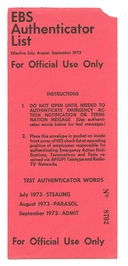 At every station, somewhere close to the teletype machine, there was an
envelope containing the Authenticator Words for activation of the Emergency Broadcast
System. It is difficult to imagine a situation when knowledge of the Authenticator
Words would have made any difference, because if someone were to have maliciously originated
a false National Emergency alert on the teletype circuit, it would have been easy enough to get
a copy of the Authenticator Words for that day and authenticate a false alarm. Anyway, the
Authenticator Words were to remain in a sealed envelope and were to be available to the operator on
duty, in the event of an FCC inspection, which was more likely than a nuclear
attack, although FCC visits are pretty rare. (I've worked as a
broadcast technician since 1971 and I have seen an FCC inspector in a broadcast
station only once. And even that incident wasn't a routine inspection... but that's
another story.)
At every station, somewhere close to the teletype machine, there was an
envelope containing the Authenticator Words for activation of the Emergency Broadcast
System. It is difficult to imagine a situation when knowledge of the Authenticator
Words would have made any difference, because if someone were to have maliciously originated
a false National Emergency alert on the teletype circuit, it would have been easy enough to get
a copy of the Authenticator Words for that day and authenticate a false alarm. Anyway, the
Authenticator Words were to remain in a sealed envelope and were to be available to the operator on
duty, in the event of an FCC inspection, which was more likely than a nuclear
attack, although FCC visits are pretty rare. (I've worked as a
broadcast technician since 1971 and I have seen an FCC inspector in a broadcast
station only once. And even that incident wasn't a routine inspection... but that's
another story.)
The envelope was about 4-by-9 inches and contained a
single 8½ by 11 inch page of information.
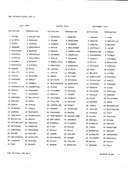 A new Authenticator Word List arrived in the mail every three months and the old list
was almost always tossed in the trash. Once in a while someone would take the
old list home, file it away, and wait for the internet to be invented so he could
show everyone what the list looked like.
A new Authenticator Word List arrived in the mail every three months and the old list
was almost always tossed in the trash. Once in a while someone would take the
old list home, file it away, and wait for the internet to be invented so he could
show everyone what the list looked like.
Almost all the words were two or three syllables, and only rarely were they
less than six letters long. There was one activation word and one termination
(all clear) word for each day of the month, and a few extra words for days like
September 31.
 If the alert message was received on the teletype,
and the Authentication Word matched, the announcer was to supposed to send the
attention signal, (and by that I mean
the old attention signal), then
begin reading the alert message scripts and stand by for further
instructions. See details below.
If the alert message was received on the teletype,
and the Authentication Word matched, the announcer was to supposed to send the
attention signal, (and by that I mean
the old attention signal), then
begin reading the alert message scripts and stand by for further
instructions. See details below.
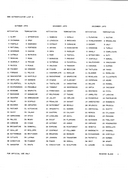 Here is another list from later that year. It doesn't look like much,
just column after column of peculiar words which seem rather dull. But
if there had ever been a reason to rip open the envelope and check the
password for that day, it would have been a tense moment indeed.
Here is another list from later that year. It doesn't look like much,
just column after column of peculiar words which seem rather dull. But
if there had ever been a reason to rip open the envelope and check the
password for that day, it would have been a tense moment indeed.
 Here is a closer look at the October through December list. I don't want
to burst anyone's bubble, but I really don't think this system would have held up
under any great pressure. Very few announcers that I knew in 1973 would have
stayed at their posts, had they been convinced that an enemy attack was imminent.
Here is a closer look at the October through December list. I don't want
to burst anyone's bubble, but I really don't think this system would have held up
under any great pressure. Very few announcers that I knew in 1973 would have
stayed at their posts, had they been convinced that an enemy attack was imminent.
 I'm glad we were never put to the
test. The old Emergency Broadcast System has been replaced and modernized
twice since these old lists were part of the system. The latest version — the
Emergency Alert System or EAS — isn't
entirely free of bugs, and is tested far more than is necessary, but it carries much
more information than the old EBS system. Some sort of alert system will almost
certainly be a part of every broadcast station from now on.
I'm glad we were never put to the
test. The old Emergency Broadcast System has been replaced and modernized
twice since these old lists were part of the system. The latest version — the
Emergency Alert System or EAS — isn't
entirely free of bugs, and is tested far more than is necessary, but it carries much
more information than the old EBS system. Some sort of alert system will almost
certainly be a part of every broadcast station from now on.
Incidentally, here is an interesting web page about the
EBS false alarm of
February 20th, 1971.
A tip of the hat to KI4QGJ for pointing out these three items:
WOWO EBS False Alarm: Aircheck from
the morning of February 20, 1971.
Pre-recorded EBS warning which was
to be used in the event of a national emergency.
Conelrad test, 1956.
I wasn't aware of this, but apparently there once was a nation-wide Conelrad test where every AM
radio station either went off the air or switched to 640 or 1240 kHz.
The Editor says...
YouTube appears to be a good source of audio and film from the Cold War, if you have all day
to explore it.
Updated 10/11/2008:
A helpful reader warmed up his scanner and sent in a couple of relevant documents
from 1994: An EBS Authenticator List and its envelope. Instead of
code words, this list uses pairs of words from
the ICAO phonetic alphabet.
This technique is somewhat less secure, if you ask me, because it provides for only 676 possible
passwords for EBS activation or deactivation.
Notice also that the authors of the 1994 lists continued the tradition of providing
authenticators for February 31 and other impossible dates.
As usual, click to enlarge.
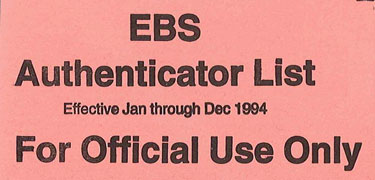
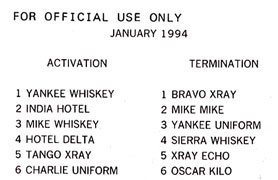
Sidebar discussion:
The latest version of the EAS may be more helpful than you'd like.
FCC's
Emergency Alert System Coming to Your Cell Phone Soon. The Emergency
Alert System (EAS) has "fallen into disarray and needs major reform," concluded FCC
Chairman Michael Powell recently as he announced agency plans to revamp the system,
according to a report in Broadcasting and Cable.
Bear in mind that it was the FCC that devised the current EAS system. Now,
after they have added more and more uses for it, such as Amber Alerts, they say it
has "fallen into disarray". Supposedly the new modernized version of EAS will be able
to turn your TV or radio on, if it isn't already. (Why not just make it illegal
to turn the TV off, like the telescreens in
Orwell's 1984?) Imagine
the power surge when an alert goes off in a major market, and millions of TV sets power up at
the same time!
Charles W. Rhodes discusses this type of feature in his
article, Poised
at the Great Analog/DTV Divide. He says, "Americans buy approximately 20 million TV
receivers a year. The average life of a TV set is said to be eight years." Thus a
new function can be incorporated in new television sets (like receiving alerts while the TV appears
to be off) and most people will have it within one decade.
On the other hand, it might take only a few minutes to change the behavior of TV sets all over the
country. Here's how: Digital TV broadcasts in the U.S. will soon have
a number of new features that you may or may not like. One of them is called
the Software Download Data Service, which
is a means of upgrading the software in TV receivers by having the TV stations broadcast the new
software to any receiver that will accept it. But don't assume that all the software upgrades will
originate from the manufacturer. This is potentially a dream come true for hackers, advertisers or
socialist dictators. You may find your TV set suddenly has new "features" that you don't really
want… like you can't turn it off, you can't turn down the volume, you can't change the channel.
It sounds like an idea for a sci-fi novel.
Related material:
UK
phones [will] sound [simultaneously] in [an] emergency drill. Tens of millions of
mobile phones across the UK will blare a siren sound at the same time on Sunday [9/7/2025] as part
of government efforts to better prepare for national emergencies. The nationwide test comes
as officials seek to strengthen the country's resilience amid more frequent extreme weather events
and concerns around Russia's war in Ukraine. At 3:00 pm (1400 GMT), most of Britain's
87 million mobile phones and tablets will emit the noise and vibrate for about
10 seconds, the government has said.
The Editor says...
By conducting tests like this, the government is training you to ignore emergency alerts.
[British]
phones to blast out 'emergency alarm' in system test as the Government warns UK to prepare for
war. The UK will test its emergency alarm system for the first time in two years, as
the Government warns Britain to prepare for war. All UK devices will blast out an alarm tone
later this year in a new test of the 'Emergency Alert System'. First launched in 2023, this
system is designed to warn the public if there is a danger to life nearby.
The Editor says...
Brace yourselves, all ye serfs. Soon your phone will make horrific screeching alert sounds at the worst
possible moment, to tell you about a kidnapping 200 miles away, or a thunderstorm that you already knew
was coming. Dig into the "Settings" menu on your phone and see if you can opt out. If the
government is as proud of the new EAS as it appears to be, you probably can't opt out.
Remember, the government can't keep you safe from every threat, which they have abundantly proven
by allowing thousands of 7th-century sand farmers to immigrate from Africa, legally or not.
Incompetence:
Entire LA County of 9.6 million Residents Mistakenly Told to Evacuate. As if the
people in/around the Los Angeles area didn't have enough to worry about. Apparently, the
entire population of 9.6 million residents was mistakenly told to evacuate their homes around
4pm local time, according to Los Angeles County Supervisor Janice Hahn. The emergency alert
was supposed to be for a specific region 'impacted by the Kenneth Fire in Woodland Hills.'
However, someone sent the alert to every resident in the greater Los Angeles region, creating
massive anxiety and exacerbating an already tense situation.
Los
Angeles County Fire Department Accidentally Sends Evacuation Alert to All of L.A. County.
The Los Angeles County Fire Department erroneously sent an evacuation warning text message alert to
all of Los Angeles County on Thursday afternoon, inflicting more panic and confusion on an already
traumatized public coping with the most damaging fires in Los Angeles history. The text message
was sent at approximated 3:57 PM Pacific time to residents throughout Los Angeles County.
It stated: "NEW: This is an emergency message from the Los Angeles County Fire Department. An
EVACUATION WARNING has been issued in your area. Remain vigilant of any threats and be ready
to evacuate. Gather loved ones, pets, and supplies. Continue to monitor local weather,
news, and the webpage alertla.org for more information."
The Editor says...
This is another reason you should opt-out of all government messages on your cell phone: Amber
Alerts, EAS tests, presidential statements, and weather warnings. Turn all of it off.
This will diminish the audience that the would-be tyrants think they have at their fingertips.
When was the last time any of those messages told you something you didn't already know? Just
use your phone to place calls and receive calls — when you're not driving —
and stop staring at the stupid phone all day.
Why
Is The Emergency Broadcast System Testing Itself For 2 Hours Just Outside Of DC?
This is the eerie scene since 4 am this morning, this has been going on in Northern Virginia
outside DC for 2 hours. The woman in the video says the buildings in view are secure
government structures, so is the emergency broadcast test a glitch or is the government expecting
something big to happen? Reports from Northern Texas say they are hearing the same test over
and over again. [Video clip]
Massive
emergency alert test will sound alarms on US cellphones, TVs and radios in October.
On Wednesday, October 4 at 2:20 p.m. ET, every TV, radio and cellphone in the United
States should blare out the distinctive, jarring electronic warning tone of an emergency alert,
accompanied by a notice along these lines: "This is a nationwide test of the Emergency Alert
System, issued by the Federal Emergency Management Agency, covering the United States from 14:20 to
14:50 hours ET. This is only a test. No action is required by the public."
Nit-picking fact check: The alert is all electronic. It does not have mass.
Massive
Emergency Alert Test to Sound Alarms on all U.S. Cellphones, TVs, Radios. A massive
emergency alert test will reportedly sound alarms on all U.S. cellphones, television sets, and
radios in October, in the wake of the deadly wildfires on the Hawaiian island of Maui. On
October 4, every cellphone, TV, and radio in the United States will blast a warning tone of an
emergency alert, in order to ensure that the nation's Emergency Alert system is working correctly
in the event of a national disaster or attack, according to a report by USA Today.
The Editor says...
The Emergency Alert System needs to be updated (again) to make participation entirely optional.
TV receivers, which are now all digital, pick up a lot of information that the viewer can ignore if
he likes: Things like program descriptions, the upcoming schedule, and station
identification. The EAS should be sent in the PSIP tables, so you can opt out if you're not
interested. Annoying monthly tests would then be eliminated, at least on television.
Emergency
Alert test descends into chaos as it fails to work on up to 10 million phones. The
national emergency alert system test descended into a farce on Sunday after it failed to work on up
to ten million phones. Technology experts are scrambling to understand why customers on
Three, one of Britain's biggest mobile networks, failed to receive the 10-second alert. The
Government insisted the test had been a "success". However, senior MPs suggested the scheme
was a waste of taxpayers' money that should be scrapped. Jacob Rees-Mogg, the former Cabinet
minister, said it was an "expansion of the reach of the state" that was "redundant". Some
phones received the alarm up to 20 minutes after the scheduled 3 pm test. The
cacophony caused by the siren going off at various intervals prompted the World Snooker
Championship to be delayed to prevent players from being put off their strokes. Welsh
speakers were also perturbed to receive a message that made no sense after the computerised system
made up the word "Vogel", which is a ski resort in Slovenia. The letter 'V' does not exist in
the Welsh language.
Floridians
jolted awake at 4.45am with accidental emergency alert. Florida residents were jolted
awake at 04:45 on Thursday morning by an accidental emergency alert on their phones.
Officials apologised to Floridians for disturbing their sleep, and said the alert was meant to be
on TV. "We know a 4:45 AM wake up call isn't ideal," the Florida Division of Emergency
Management said, adding that they test emergency alerts on a variety of platforms. "This alert
was supposed to be on TV, and not disturb anyone already sleeping," the agency added. "We are
taking the appropriate action to ensure this will never happen again and that only true emergencies
are sent as alerts in the middle of the night."
California
bill would create missing persons alert ONLY for black women [and] children. A new
bill proposed in California would create an "Ebony Alert" system to specifically notifiy the public
when black women and children go missing. While the state already has a missing persons alert
system, this one would only be for black women and children. The state currently has an Amber
Alert for missing children, a Silver Alert for missing elderly persons, and a Feather Alert for
missing indigenous persons. The Amber Alert system is not race-segregated like the Ebony
Alert would be. In a release on the race-based crime bill, state senator Steven Bradford said
that the bill would "address the often ignored or lack of attention given to Black children and
young Black women that are missing in California."
In England:
Beware
the smart phone emergency alerts. Two weekends hence, on Sunday April 23, every
mobile phone user, adults and children alike, will be assailed by an unpredecented 'emergency
alert'. You will hear a loud siren-like sound for up to ten seconds. You must
acknowledge it on your phone screen before you can return to other features on your phone.
This is the first nationwide use of a new system being launched by the Government to 'warn you
about serious nearby threats to life'. You can read the Government spiel about it here. It
says: 'Emergency Alerts will be used very rarely — only being sent where there is an
immediate risk to people's lives — so people may not receive an alert for months, or
even years.' Examples given are wildfires and flooding, but it also mentions an 'an ever-evolving
range of threats'. It adds: 'The alerts are secure, free to receive, and one-way. They
do not reveal anyone's location or collect personal data.' However, many are suspicious that
this system is not as innocuous as they would have you believe.
Taking false alarms to the next level:
Terrified
Russians are ordered to take anti-radiation pills and rush to nuclear bomb shelters as TV station
servers are hacked. Russians were warned today to take anti-radiation pills and rush
to their nearest nuclear bomb shelters after hackers compromised state television servers to
broadcast chilling messages. TV and radio programmes in Moscow and the Sverdlovsk region,
including Yekaterinburg city, were interrupted with an alarming message telling citizens a missile
strike had been conducted on Russian soil. The population was urged to take potassium iodide
pills, don gas masks to protect themselves and to seek shelter.
Using
Emergency Alert System to Remind People to Vote is a Bad Idea. President Joe Biden and actor Jason Bateman
debated the best way to encourage Americans to vote in the upcoming midterm elections. On the Wednesday edition of
the SmartLess podcast, Biden sat down with hosts Jason Bateman, Sean Hayes, and Will Arnett to discuss his career
and current state of the country. [...] The actor would clarify that the alert would not advocate for either party but
serve as a helpful reminder ahead of Election Day. "Could I ask you to commit to consider over the next few days
using your unique power as president to utilize the emergency alert system?" Bateman asked.
Desperate
Netflix Star Urges Biden to Activate Emergency Alert System to Encourage People to Vote Democrat.
[Scroll down] First, Republican voters aren't a monolithic group of mindless people who universally believe the
2020 presidential election was "rigged" or "stolen." Moreover, I suspect a sizeable percentage of objective
Republicans don't believe substantive proof has been presented to support the claim, but feel pressured to say
they do, fearing retribution from "you know who" and his unchangeable loyalists. Second, Bateman's "This is
what they're saying that their plan is" is a nonsensical [pack of lies]. Bateman did acknowledge the purpose
of the Emergency Alert System, but then played the Democrats' go-to "existential threat" card: ["]It's
usually for the weather or killers or kidnapping, whatever. But I don't think it's an exaggeration to categorize
this as, as a light crisis, an existential threat.["] He then argued that a simple 20-second card flashing
on the screen would be enough to encourage voters to "get out and let their voices be heard" (vote Democrat and save the
Republic).
The Editor says...
This sounds like a "trial balloon." The use of the Emergency Alert System for purely political purposes
is a revolting misuse of a system that is in place to warn the general public about impending danger —
usually tornado warnings. (EAS is the latest version
of CONELRAD, which was a system that was
set up in 1951 to warn of incoming enemy invasions or missiles.) EAS messages can't be muted or ignored on your TV
or your cell phone. (When I'm President, all that will change!) If a politician had suggested this idea, it would
have been politically costly to him and his party. But if a celebrity brings it up, and for whatever reason there
isn't widespread outrage, then the politicians can pick up the ball and run with it. To anyone with common
sense, the election of Republicans — the ones who can overcome Democrat election fraud — is not an emergency.
The poorly-educated leftists act like this whole country is a big toy that the President can play with in any way he chooses.
LA
public officials accidentally broadcast TV warning telling [the] entire city to evacuate. Los
Angeles County residents were in for quite a scare as they accidentally received an emergency evacuation
notice on their TVs. An evacuation order for Eastern North Pacific Ocean, Guadalupe Island, Los Angeles,
and Ventura County was issued at around 5 pm on Wednesday. However, a little over an hour later,
authorities pulled the notice and the Ventura County Sheriff's Office later announced it was 'sent in error
by the County of Los Angeles.'
The Editor says...
Ri-i-i-ight. It was "sent in error by the County of Los Angeles," is a handy way to phrase it,
so nobody will ask who pushed the button? and did anyone get fired for this? Malfunctions
of this sort — whether due to hackers or to incompetent government employees — accomplish
only one thing: They train you to ignore "emergency alerts" from any level of government.
EAS hacked in Montana.
A terrifying emergency broadcast shocked local Montana residents on Monday [2/11/2013] when KRTV's midday programming was interrupted by a report of "dead bodies"
"rising from their graves" in several counties. [...] KRTV posted a notice on the internet apologizing for the mistake and blaming a hacker for the erroneous report
of a zombie attack.
Insecurity plagues US emergency alert system. The EAS is
increasingly under fire by critics who charge that its national mission is obsolete in an era of instant 24-hour news coverage, and that the technology underlying it is
deeply flawed. One of the most stinging criticisms: that the EAS is wildly vulnerable to spoofing, potentially allowing a malefactor to launch their own
message that in some scenarios could quickly spread from broadcaster to broadcaster like a virus.
This Is Only a Test. Remember when the emergency broadcast system sounded on
your television on Sept. 11, 2001? ... Perhaps you don't remember because it never happened. Neither the Emergency Broadcast System (EBS) nor its successor,
the Emergency Alert System (EAS), made a peep on 9/11. The lack of noise sparked a public debate about the system's usefulness.
Alert System's Deafening
Silence: While there is little doubt most Americans consider the September 11 terrorist attacks against the World Trade Center and the
Pentagon to have been a national emergency, the nation's emergency-alert system remained silent. Why? And if the outrages of September 11 did
not constitute a national emergency, what would?
The Editor says...
The easiest explanation for the silence of the EAS is that every network affiliated TV station was talking about nothing but the attacks for several days, starting just
after the first plane hit the World Trade Center. Since it was a surprise attack, there was no way to issue a warning beforehand. The only way for EAS to
come into play would have been if NORAD or some other agency had seen the attack coming. Thus the EAS is good for tornado, volcano, flood, blizzard and tsunami
warnings, but not very helpful in the event of an earthquake or surprise attack.
EAS Test Mistakenly Calls for the Evacuation of Connecticut. Despite what residents may have
seen on television, the state of Connecticut was not ordered evacuated on Tuesday [2/1/2005]. State emergency management officials said a worker
entered the wrong code during the weekly test of the emergency alert system, leading television viewers and radio listeners to believe that the state
was being evacuated.
Bogus
Homeland Alerts Hit the Air. As if Florida didn't have enough
to worry about this hurricane season, some residents of the Sunshine State
were alerted to a nonexistent radiological emergency last Wednesday [7/27/2005] after a
National Weather Service operator fat-fingered a routine test of the
Emergency Alert System.
Tsunami warning inadvertently
sent out. A National Weather Service worker inadvertently sent a tsunami warning to Alaska
radio and television stations Monday [2/6/2006] as employees were reviewing procedures to issue such
alerts.
Crisis
Alert in Critical State. Even if the president were to declare
a national emergency and take over the nation's airwaves for an announcement,
cumbersome alert systems and the glut of unmanned radio stations would make
it hard to get the word out. Never mind if the warning came in the middle
of the night when most Americans aren't paying attention to TV or radio.
Fraudulent Amber Alerts: Amber Alerts are general
notifications in the first few hours after a child has been abducted. The idea is that if you get the word out
quickly, you have a better chance of recovering the child. There's an interesting social dynamic here, though.
If you issue too many of these, the public starts ignoring them. This is doubly true if the alerts turn out to be
false. That's why two hoax Amber Alerts in September [2007] are a big deal. And it's a disturbing trend.
Updated 8/4/2006:
Bush
Orders Update of Emergency Alert System. President Bush yesterday [6/26/2006] ordered
Homeland Security Secretary Michael Chertoff to overhaul the nation's hodgepodge of public warning
systems, acknowledging a critical weakness unaddressed since the 2001 terrorist attacks and exposed
again last year by Hurricane Katrina. The Emergency Alert System, best known for weather
bulletins and Amber Alerts for missing children, should be upgraded to explore communicating by
cellphones, personal digital assistants and text pagers targeted to geographic areas or specific
groups, U.S. officials said.
Updated 8/15/2008:
Missile
message mistakenly played in Japan. Government workers throughout Aichi Prefecture in
western Japan heard a message saying there was a ballistic missile attack after it was mistakenly
played. ... Local government spokesman Masashi Aoyama said the message was broadcast by accident
on Wednesday [8/13/2008] during a test at city hall in Nagoya, 170 miles west of Tokyo.
Updated 6/11/2007:
FCC Takes Action to Strengthen
EAS. The Order requires EAS participants to accept messages using Common Alerting Protocol (CAP),
the groundwork for Next Generation EAS delivery systems, no later than 180 days after FEMA announces its adoption
of standards in each case.
US unveils
EAS for mobile phones and computers. The US government unveiled a communications
system that in case of emergency should soon allow it to send SMS alerts to Americans' mobile
phones and computers. "We have the ability to do this. It's a major step," Federal
Emergency Management Agency (FEMA) Director David Paulson told reporters outside the US capital
as he unveiled the program's design.
Editor's Note:
In the article above, SMS stands for Short Message
Service.
Updated 4/10/2008:
Nationwide
text message alert system approved. Federal regulators Wednesday [4/9/2008] approved a plan to create a
nationwide emergency alert system using text messages delivered to cellphones. Text messages have
exploded in popularity in recent years, particularly among young people. The wireless industry's trade
association, CTIA, estimates more than 48 billion text messages are sent each month. The plan stems
from the Warning Alert and Response Network Act, a 2006 federal law that requires upgrades to the nation's
emergency alert system.
FCC Approves Emergency Alerts Via TXT
Messages. The FCC says in an effort to better warn you about emergencies a new text message
warning system will be in place. The text messaging system comes in response to the Warning, Alert and
Response Network Act (WARN Act) which required the FCC to establish new and effective ways of alerting the
public to emergencies.
Cellphone text-alert system OK'd. Federal
regulators Wednesday [4/9/2008] approved a plan to create a nationwide emergency-alert system using text
messages delivered to cellphones. Texting has exploded in popularity in recent years, particularly among young
people. The wireless industry's trade association, CTIA, estimates more than 48 billion text
messages are sent each month. ... Cellphone subscribers would be able to opt out of the program.
Full text of H.R. 5556 [109th]:
Warning, Alert, and Response Network Act. [Scroll down to the bottom] The Assistant Secretary for
Communications and Information of the Department of Commerce may borrow from the Treasury beginning on
October 1, 2006, such sums as may be necessary, but not to exceed $106,000,000, to implement this
section. The Assistant Secretary shall reimburse the Treasury, without interest, as funds are deposited
into the Digital Television Transition and Public Safety Fund.
FCC approves rules that would create national
cell phone alert system in U.S. U.S. federal regulators have approved a plan to create a
nationwide emergency alert system using text messages delivered to cell phones.
FCC: Presidential emergency alerts
to be tested. [Scroll down] At the same time, said [Lisa] Fowlkes, the FCC is looking at
how wireless broadband could also enhance the EAS as part of a recommendation that was in the FCC's National
Broadband Plan from last year. The idea is to leverage broadband and the Internet for emergency
alerting with the "Commercial Mobile Alert System (CMAS) being developed by FEMA and the wireless industry."
Added 10/3/2007:
Society of Broadcast Engineers opposes live code testing of
EAS. The SBE asserts that these cry-wolf alerts will potentially cause public alarm, weaken
confidence in the EAS for real alerts and discourage broadcaster's involvement with volunteer EAS programs.
Broadcasters and cable systems decode the EAS data and send the information directly to scrolling messages on
TV screens and radios. One result of live-code tests would be that TV's viewed by the deaf and hard of
hearing, and TVs in public places would not show any indication that the message is not a real alert.
Update 1/31/2011:
Emergency Alert System Test Concludes In
Alaska. As part of ongoing national preparedness planning efforts, The Department of Homeland
Security's Federal Emergency Management Agency (FEMA), the Federal Communications Commission (FCC), the State
of Alaska, and the Alaska Broadcasters' Association (ABA) conducted a statewide live-code test of the
Emergency Alert System (EAS) in Alaska yesterday (on Wednesday, January 26, 2011, at 10 a.m.
local time).
Added 5/11/2011:
Emergency Alert System
to Be Announced in NYC. A new national emergency alert system that will send messages to cell
phones during disasters will be launched in New York City by the end of the year.
Emergency
alert system set to launch. If you get an urgent message on your cell phone from President Obama
later this year, it's not a prank. Under a new emergency notification system being announced tomorrow by
Mayor Bloomberg and federal officials, anyone carrying an "enabled" mobile device within range of a cell phone
tower would be alerted what to do in case of emergency.
Your president is calling.
"The system — called PLAN or Personal Localized Alerting Network — uses cell phone
towers to send messages to everyone currently in a certain area, regardless of whether they're visiting
from out of town or have a phone registered elsewhere. People won't have to register in advance to
receive the alerts. "The messages, including urgent blasts from the President, information on
imminent threats and Amber Alerts about missing children, will supercede all other phone traffic
so they won't be stalled or delayed."
[Emphasis added.]
The
first five Presidential Emergency Text Messages. The nation's top cell phone carriers
(Verizon and AT&T) are already signed on for the system, but users can opt out of receiving the local alerts
and Amber alerts. However, no one will be able to opt out of the Presidential Alerts, which as
a result will eventually become compulsory for all cell phone users nationwide.
[Emphasis in original.]
Added 12/24/2013:
Now Hear This: Big Brother Wants to
Talk to You. Right Now!. It's not like we don't hear from our president often enough. But Uncle Sam — having failed to devise
its own system that could put the president's words out to all citizens within minutes — is reaching out to the private sector for help.
His goal? So the "President of the United States can alert and warn the American people under all conditions." How quickly?
Within 10 minutes, and preferably within five.
Don't mention the war: The 1955
BBC plan for surviving nuclear armageddon. In the event of all-out nuclear war, the BBC was
to distract the nation by broadcasting a mix of music and light entertainment shows, secret papers released
by the Home Office reveal. Hundreds of security-vetted BBC staff and a select band of unnamed radio
artistes were to be clandestinely dispatched to transmission sites across the country at the first signs
of international tension.
The Doomsday Public Service Announcement: One
day, as the legend/rumor goes, [President Eisenhower] asked/ordered [Arthur] Godfrey to tape what can
only be described as the ultimate PSA. In the message, Godfrey supposedly announces that the country
is under atomic attack, that all measures are being taken to defend the population and, most importantly,
we WILL survive. [People are still looking for
the film, but it's apparently well hidden, if it exists at all.]
NORAD 'Cold War Room' Put on
Ice. Dr. Strangelove would have a heart attack. America's vaunted underground war room
deep inside this granite mountain is being retired. Not only that, but Russian military men have been
inside the place.
WGU-20: WGU-20 was originally
designed to be part of the Decision Information Distribution System (DIDS) that would be used
to alert the public of an enemy attack (along the same lines as the then-current Emergency
Broadcast System). As originally envisioned, many home devices, including radios, TV
and even smoke detectors, would have inexpensive longwave receivers built into them ensuring
the that attack message would get out. The DIDS system was never implemented and the
job of attack warning in the US remained with the EBS (now the Emergency Alert System).
The Editor says...
If another situation as tense as the Cuban Missile Crisis ever develops, practically everybody who cares
will be watching TV. The chances of an attack coming as a complete surprise are practically nil.
We're All Soldiers of Fortune Now.
Survival kits and disaster preparedness used to be something out of the mainstream. After a brief (and
heavily-mocked) period of fallout-shelter construction in the late 1950s and early 1960s, the notion of
private disaster preparedness retreated from the mainstream. Survival kits and equipment were
available, but mostly through military surplus stores and other specialty sources. But now
that seems to have changed.
More about the history of Conelrad:
[Scroll down] If an air raid was believed to be imminent, air raid sirens would have sounded the alarm
and all broadcasters in the area would shut down their AM broadcast transmitters and selected stations would
retune to either 640 kc or 1240 kc and return to the air. The public would turn on their
radio and retune to either CONELRAD frequency to receive instructions. This wasn't an emergency alarm
system, as the public would have already been alerted by the sound of air raid sirens, but it would advise
the public of what to do about the impending danger. The concept behind CONELRAD was to deny enemy
bombers any ability to use radio broadcast signals to navigate to their targets by means of radio direction
finders which had been used successfully in World War II at Pearl Harbor.
The Editor says...
Note that if Conelrad had been activated, most AM radio stations would sign off immediately,
and one station in each region would go to 640 or 1240 kilocycles. If I'm not mistaken,
the relatively few FM and TV stations would have had to go off the air and stay off for the
duration of the emergency. I've heard old-timers say that the early Conelrad tests
required the primary stations to shift to 640 or 1240 kc, and it wasn't easy to
get a transmitter re-tuned to 640 kc.
Another page with tons of information about Conelrad, EBS and EAS can be
found here.
April 1961 Conelrad Card: An
authentic "Report of Weekly Test of Conelrad Teletype Alerting System", FCC
Form 6A, from April, 1961. This card was to be filled out and mailed
when a broadcast station received a test via their news teletype service.
Listen to this 60-second
Conelrad PSA, introduced by Dennis James.
If you're looking for general US Broadcast
History, check out this page.
If you're studying broadcast history in Dallas,
check out this page.
Other technical issues like Closed Captioning, HDTV and the V-Chip, are discussed on
this page.
Duck and Cover with Bert the Turtle. Educational
film produced in 1950, during the first big Civil Defense push of the Cold War.
The CONELRAD plan for Hawaii, June 7, 1956.
Added 7/4/2008:
The Civil Defense Museum is an
excellent source of information about Civil Defense shelters, survival rations and sirens, especially
in the Dallas area.
Section 2½: The first national EAS test, November 9, 2011.
Items published before the test:
November 9th's USA Nationwide Communication Blackout.
In its wisdom, the Federal Communications Commission (FCC) issued a Public Notice on June 9, 2011 that
its first ever nationwide diagnostic test of the Emergency Alert System (EAS) would occur on November 9.
Reasons sketched out by FCC for the Nov. 9 test date include not wanting to test in the traditional hurricane
season and to complete the task before severe winter storm set in. The 2 p.m. test time will minimize
disruption during rush hours while ensuring the test occurs during working hours.
Final Implementation Phase of Obama Formal
Dictatorship has Begun. [Scroll down] Now, in a secondary move to seize all power in the
country for himself and his syndicate, Obama has decided that he will confiscate ALL television and Radio
broadcasts for a supposed "test" of the EAS (Emergency Alert System). Communication for both US television
and Radio will be cut off on 9 November 2011 for at least 3-4 minutes. This is both unprecedented
in our history and constitutes the final phase of Obama's testing of his ability to seize communications in the
USA at will.
Did
You Know Feds Will Temporarily Cut Off All TV and Radio Broadcasts on Nov. 9? If you have ever
wondered about the government's ability to control the civilian airwaves, you will have your answer on November 9th.
On that day, federal authorities are going to shut off all television and radio communications simultaneously
at 2:00PM EST to complete the first ever test of the national Emergency Alert System (EAS). This
isn't a wild conspiracy theory. The upcoming test is posted on the Public Safety and Homeland Security
Bureau website.
First-ever
national test of emergency alert system set for Nov. 9. Next week, at 2 p.m. ET on
Nov. 9, every American radio and TV provider will participate in the first-ever simultaneous nationwide
test of the Emergency Alert System. The three-minute alert — the traditional beeps and tones — will
run on all channels.
FEMA
urges Americans not to worry as national alert system is tested. Wednesday's test will look and
sound very similar to the local tests of the Emergency Alert System that occur frequently; the public will hear a
message indicating that 'This is a test' on broadcast radio and television stations, cable television, satellite
radio and television services and wireline video service providers. The disruption will occur across all
states and the territories of Puerto Rico, the U.S. Virgin Islands and American Samoa.
FCC
Releases Handbook for Nationwide EAS Test. The FCC has released its EAS
Handbook*,
specially directed to the Nationwide EAS Alert that will occur on November 9.
First
nationwide EAS test to be conducted today. Initially, the test was to last three minutes, but
officials reduced that timeframe to 30 seconds Nov. 4. "After a careful review of the technical
elements of the test, FEMA and the FCC have concluded that a thirty-second test will allow the agencies to
effectively assess the reliability and effectiveness of the EAS as a way to alert the public of national
emergencies with limited disruption to the public," said a statement from FCC officials.
Items published after the test:
Emergency Alert System Fails.
Americans have become accustomed to their government spending staggering amounts of money on [stuff] that
doesn't work, so today's Emergency Alert System test was pretty much par for the course. Compared to
"green energy" programs, it was a smashing success, unless you happen to live in sparsely populated areas like
Chattanooga or New York City. Just keep your ears peeled in the future, as you will probably hear
either a warning tone and important instructions, or a Lady Gaga song, within ten minutes or so of a
major national catastrophe.
Glitches
Reported During FEMA's First-Ever National Emergency Alert System Test. The 30-second test of the
emergency alert system was scheduled to begin at 2 p.m. Eastern Time, but it appears there were problems
with the audio message.
Poor Grades for
Emergency Alert Test. The test was supposed to run 30 seconds. WJLA-TV in Washington
was stuck on a test graphic for four full minutes. WMAL-FM in Washington was stuck in silence for nearly
two minutes before the test finally ran, and when it did, listeners heard double or triple audio. One of
ABC's radio affiliates, WAPI in Birmingham, Ala., tweeted this: "Did not air on any station in our cluster,
or any TV station in the market. Callers with DirecTV report seeing Lady Gaga."
So
what happens in a REAL emergency? First test of national alert system flops. It is a relic from
the Cold War, designed to get information from the White House to the people, should the worst happen. And
there was something distinctly 20th century about the first test of the national alert system — immediately
derided as 'a flop'.
Section Three: More about the EBS system
I found some additional material in my garage with which I can elaborate on the EBS
system. All this was found in the trash at a local television
station several years ago, in the form of a three-ring binder containing
the Detailed Operational Plan for the Emergency Broadcast System. (It is safe
to assume that the new copy of the Operational Plan is tucked away in someone's
office. It's supposed to be.) Some of the old material was pretty
ominous. The FCC was preparing broadcast stations for all-out atomic warfare
in which millions of people might have been killed and the telephone system would
be used only for high-priority messages.
Here is some of what's in the three-ring binder:
Office of Civil Defense "Statement of Requirements for the Broadcast Services".
Dated February 23, 1967. Five pages.
[1]
[2]
[3]
[4]
[5]
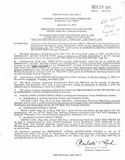 Standard
operating procedure and use of the authenticator
word list.
Standard
operating procedure and use of the authenticator
word list.
Note: Click on any of these documents to see them full size.
(That should be
obvious.)
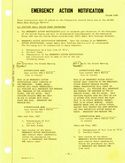 The Yellow
Card. (1275 k-bytes) This is a description of an actual emergency
notification, as opposed to a routine weekly test, which might have come across the
AP or UPI teletype wire. It describes two possible alert messages, with or without
an attack warning. The alert message would tell you to grab the Red Card
or the White Card and follow those directions.
The Yellow
Card. (1275 k-bytes) This is a description of an actual emergency
notification, as opposed to a routine weekly test, which might have come across the
AP or UPI teletype wire. It describes two possible alert messages, with or without
an attack warning. The alert message would tell you to grab the Red Card
or the White Card and follow those directions.
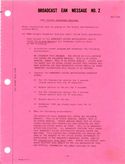 The Red
Card, front. This is the big one, an attack
warning. (1389 k-bytes)
The Red
Card, front. This is the big one, an attack
warning. (1389 k-bytes)
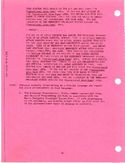 The Red
Card, back. Additional standby script with an actual attack
warning. (1430 k-bytes)
The Red
Card, back. Additional standby script with an actual attack
warning. (1430 k-bytes)
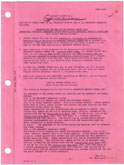 Standby Script
#2, front. More text for the very nervous chain-smoking announcer to read aloud while waiting for official
word from Washington. (1018 k-bytes)
Standby Script
#2, front. More text for the very nervous chain-smoking announcer to read aloud while waiting for official
word from Washington. (1018 k-bytes)
(Added
12/15/2011 at the suggestion of John Meshelany Jr.)
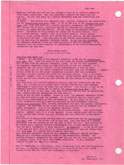 Standby Script
#2, back. (1180 k-bytes)
Standby Script
#2, back. (1180 k-bytes)
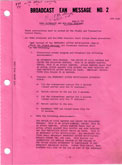 Red Card for non-NDEA stations,
front. (902 k-bytes)
Red Card for non-NDEA stations,
front. (902 k-bytes)
(Added 12/15/2011)
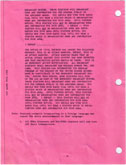 Red Card for non-NDEA stations,
back. (1060 k-bytes)
Red Card for non-NDEA stations,
back. (1060 k-bytes)
This is the script that non-participating stations would broadcast immediately before
signing off, leaving the listeners to hunt for another station (on 640 or 1240 kHz).
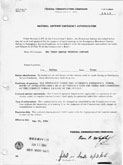 NDEA authorization. (671 k-bytes)
NDEA authorization. (671 k-bytes)
This is what a National Defense Emergency Authorization looks like.
It is essentially a license to keep broadcasting during a national emergency. It's unlikely that FCC inspectors would
have come around to ask to see it, but it had to be
kept on hand.
(Added 12/15/2011)
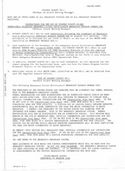 The White
Card, front. (173 k-bytes) This is the standby script
without an attack warning.
The White
Card, front. (173 k-bytes) This is the standby script
without an attack warning.
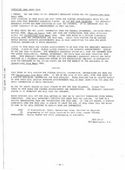 The White
Card, back. (112 k-bytes) More of the standby script. "Please
be calm! ... Please do not use your telephone!" How many people
in today's society would actually stay off the phone if they heard this on the
radio? Every 14-year-old girl in town would be on her cell phone in
five seconds, if such an announcement were made today.
The White
Card, back. (112 k-bytes) More of the standby script. "Please
be calm! ... Please do not use your telephone!" How many people
in today's society would actually stay off the phone if they heard this on the
radio? Every 14-year-old girl in town would be on her cell phone in
five seconds, if such an announcement were made today.
Perhaps that is why Area Code 710 has been reserved for the United States Government, although no
lines - other than the single telephone number 710-627-4387 ("NCS-GETS") - had
actually been connected on this code as of
2004* and even that number requires a
special access code to use.* GETS
stands for
the Government Emergency
Telecommunications Service, which is described in some
detail in various places around the internet:
[1]
[2]
[3]
[4]
[5]
[6]
[7]
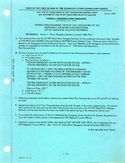 The Blue
Card. (1663 k-bytes) This card gives the
details of the weekly teletype tests. However, hardly anyone ever actually read this
card. If you went to work in a radio or TV station back in those days, with
no experience at all, the old timers would make sure that you knew about the EBS
system, and about the importance of these tests.
The Blue
Card. (1663 k-bytes) This card gives the
details of the weekly teletype tests. However, hardly anyone ever actually read this
card. If you went to work in a radio or TV station back in those days, with
no experience at all, the old timers would make sure that you knew about the EBS
system, and about the importance of these tests.
The ten-bell teletype signal was designed to attract attention in a busy newsroom where people
ordinarily ignored the noise of the teletype. Even so, some stations had alarms that were
triggered by ten quick bells on the teletype machine. (There was also a five-bell alarm used
for tornado warnings.)
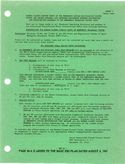 The Green
Card, front. (1736 k-bytes) This card gives the
details of the random closed-circuit tests. I have seen only one of
these tests.
The Green
Card, front. (1736 k-bytes) This card gives the
details of the random closed-circuit tests. I have seen only one of
these tests.
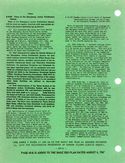 The Green
Card, back. (1736 k-bytes) More details of the random
closed-circuit tests, which were introduced in 1967.
The Green
Card, back. (1736 k-bytes) More details of the random
closed-circuit tests, which were introduced in 1967.
FCC Rules Title 47, Part 73, Subpart G: Emergency Action Notification System and the Emergency
Broadcast System. Taken from the Federal Register, April 14, 1972, these are the complete
FCC Rules effective on that date, and pertaining to EBS, including all the standby scripts, and the scripts to be
followed in the event that a station had to go off the air during a national emergency condition,
as well as the details of the old attention signal, closed circuit teletype system tests, and the
use of EBS during day-to-day emergencies like tornados. The rules also describe the four
methods which could be used to activate the Emergency Broadcast System, any one of which would
be sufficient to initiate EBS operation.
Some of this material may be of interest only to historians, but it answers a lot of
questions. For example, you may wonder why, when an EBS test was run on the radio,
the announcer always said, "The broadcasters of your area, in voluntary cooperation with
the FCC and other authorities, have developed this system…," since participation in
the Emergency Broadcast System was no more voluntary than station identification. The
answer lies in these FCC rules. The rules contain the script for weekly EBS tests. Whether
a station was cooperating voluntarily or not, that's what had to be said in an EBS test announcement.
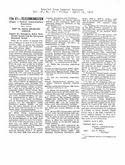
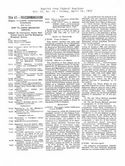
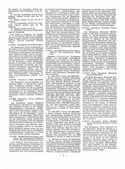
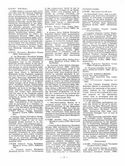
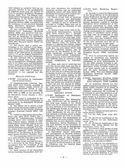
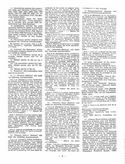
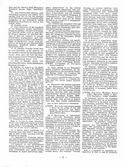
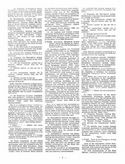
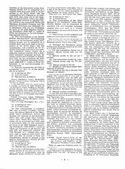
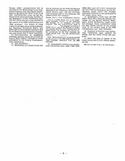
Included in the FCC rules are the detailed specifications of
the old attention signal. In
the step-by-step recipe for the old attention signal, the last two steps usually occurred
simultaneously, so the transmitter had to go from zero output power to maximum output
power (with a fully modulated tone) instantly. At the station I worked for in 1972 and
1973, EBS tests had to be run at reduced power because the old
transmitter (vintage 1955) could not send the attention signal at full power without
shutting down completely.
Below is a memo about the precedence system for the use of telephone and telegraph facilities
during a national emergency. This is a synopsis of a seven-page memo which goes into greater
detail but says roughly the same thing. The longer memo goes into greater detail about
the "procedures to insure that communications vital to the national interest will be afforded
priority handling in all situations ranging from normal peacetime conditions to various stages
of crisis, including all-out nuclear attack." Such an event was not entirely unlikely
back then.
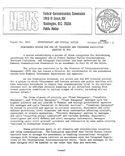
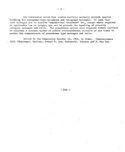
Also for broadcast historians, President Nixon's Executive Order 11490: "Assigning Emergency
Preparedness Functions to Federal Departments and Agencies." Essentially a things-to-do list for
FEMA (or the equivalent agency) in the aftermath of an attack on this country.
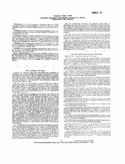
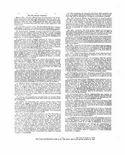
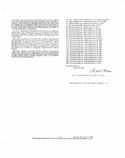
The two page document below is dated May 2, 1968. It is a memo on an FCC letterhead from Defense Commissiner Lee
Loevinger, about the FBI and the Universal Emergency Telephone Service Number (9-1-1) including a lengthy
quote from J. Edgar Hoover. Mr. Hoover didn't want people sending information to the FBI by way
of 9-1-1 operators. This was decades before 9-1-1 was in use nationwide. I had never
heard of 9-1-1 until the mid-1970's, and the 9-1-1 system in Dallas wasn't in place before 1982, as
far as I can remember, but
the history of 9-1-1 is
another subject altogether.
(If you really want to get sidetracked,
read 100 Ways to Mis-Dial 911.)
Mr. Loevinger was appointed to be a Commissioner at the FCC in 1963 by President Kennedy to
complete the term of well-known FCC Commissioner Newton Minow.
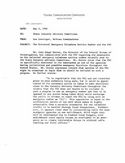
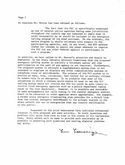
Update:
This article about Sending Photos
to 911 Operators in New York City includes a statement that the 9-1-1 system has been
in operation since 1968.
If you're on a slow dial-up internet connection, let me apologize for loading up this page with
additional graphics, but here they are anyway:
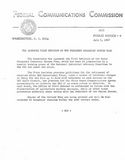 First, here is an
FCC Public Notice, dated July 5, 1967: "FCC Approves First Revision of the EBS Plan."
First, here is an
FCC Public Notice, dated July 5, 1967: "FCC Approves First Revision of the EBS Plan."
That was followed a few weeks later by this memo, dated August 1, 1967, from the Office of
Civil Defense to all broadcast stations, introducing the revised and updated National Basic EBS
Plan as approved by the FCC. This copy of the memo has been scribbled upon, in an effort to
make corrections; however, I recognize the handwriting, and the gentleman who made the notes is an
outstanding broadcast engineer who must have known what he was doing when he made these notations.
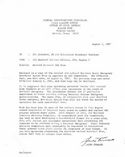
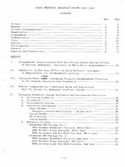
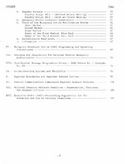
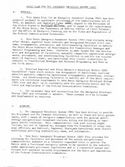
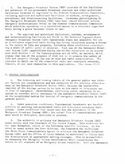
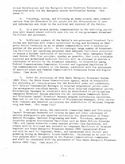
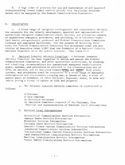
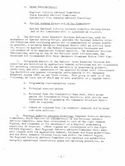
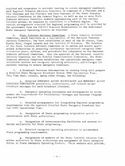
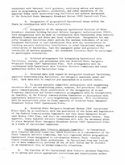
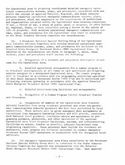
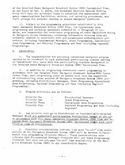
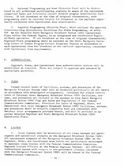
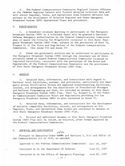
Section Four: Additional documents added April 21, 2007.
Annex V -- Notes on Authenticator Word Lists,
revised 12/23/1970.
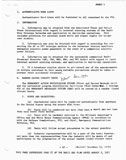
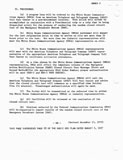
Annex V Green Card -- Random Closed Circuit Tests, First and Second Methods. These two pages are
apparently the same as the Green Card (front and back) shown above. If you would like to have a closer
look, check out the larger version: Front,
Back.
Annex VI -- EBS Programming and Operating Instructions. Includes the script for the two-minute warning
before a Presidential address.
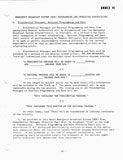
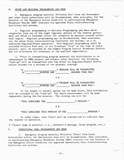
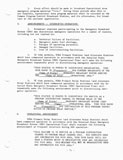
Annex VII -- Criteria for NDEA Eligibility.
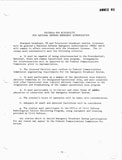
Attachment A -- Washington DC Network Origination Diagram. Shows how ABC, CBS, NBC, Mutual Radio and
the White House Communications Agency were interconnected, on a good day.
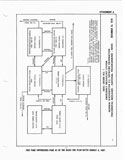
Attachment B -- First Alternate Network Network Origination. This is "Plan B" -- the
interconnections of the radio networks and the White House, apparently through a control point at an
undisclosed location -- possibly in the basement of the Greenbrier Hotel in White Sulphur Springs, West
Virginia. (Just a wild guess.)
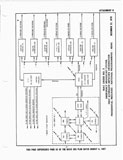
Texas Emergency Broadcast System Base Plan, November 2, 1964.
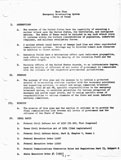
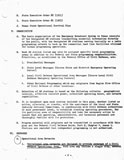
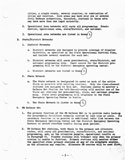
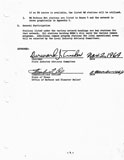
Updated 5/15/2007:
Another
page from the Detailed Texas EBS Operational Plan, specifically the Dallas Operational Area,
from September 15, 1972. What's especially interesting about this page is the old callsigns
of some of the Dallas radio and TV stations. For example, the station that is now known as
"My 27", KDFI-TV, was apparently licensed in 1972 as KLIF-TV.
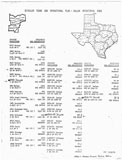
Section Five: The Two-Tone Attention Signal
The memo below shows that the development of the two-tone attention signal goes back to 1963. Its format
was apparently finalized in early 1969, and of course it is still in use today (even if only as a sound
effect -- see below). The two-tone attention signal is a mix of 853 Hz and 960 Hz, plus or
minus 0.5 Hz.
For comparison,
the buttons on the third and fourth rows of a Touch-Tone keypad
generate 852 and
941 Hz,
respectively.*
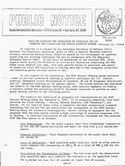
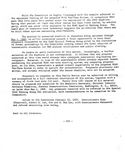
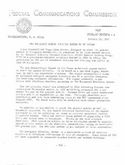 This is the FCC memo announcing
the two-tone attention signal. FCC Public Notice, October 19, 1967, "New
Emergency Public Alerting System to be Tested."
This is the FCC memo announcing
the two-tone attention signal. FCC Public Notice, October 19, 1967, "New
Emergency Public Alerting System to be Tested."
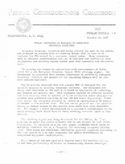 FCC Public Notice, October 19, 1967, "Public Cautioned on the
Purchase of Emergency Broadcast Receivers." It seems that someone was marketing EBS receivers
that would respond to interruptions in the RF carrier, and the FCC wanted everybody to know they
were working on a new two-tone attention signal which was "not subject to … false
activation."
FCC Public Notice, October 19, 1967, "Public Cautioned on the
Purchase of Emergency Broadcast Receivers." It seems that someone was marketing EBS receivers
that would respond to interruptions in the RF carrier, and the FCC wanted everybody to know they
were working on a new two-tone attention signal which was "not subject to … false
activation."
Updated 3/15/2006:
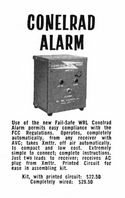 I have found an interesting
advertisement in the back of an old issue
of QST. Apparently
even ham radio operators were required to be sure the Conelrad system wasn't activated while
they were on the air. Since it would be rather challenging to carry on a conversation
in Morse Code while Wolfman Jack was blaring out of another radio on the desk, various companies
began marketing these handy receivers that were evidently triggered by the carrier interruptions in
the old attention signal. These are the receivers mentioned in the FCC Notice discussed in the
paragraph immediately above.
I have found an interesting
advertisement in the back of an old issue
of QST. Apparently
even ham radio operators were required to be sure the Conelrad system wasn't activated while
they were on the air. Since it would be rather challenging to carry on a conversation
in Morse Code while Wolfman Jack was blaring out of another radio on the desk, various companies
began marketing these handy receivers that were evidently triggered by the carrier interruptions in
the old attention signal. These are the receivers mentioned in the FCC Notice discussed in the
paragraph immediately above.
Kids these days won't know what "Kit, with printed circuit" means. Kit means they sent you a pile of
parts and you had to put it together, piece by piece. Printed circuit refers to the traces on the
circuit board, not the schematic diagram. Not many years earlier, devices like this were put together
with components soldered onto the terminals of the tube sockets, and a few solder terminal strips in between,
with lots of connecting wire and "spaghetti" insulation all around.
Updated 10/19/2006
These are two relevant patents:
Patent #4103235 -- "Two-tone
attention signal broadcasting system"
Patent #4392248 -- "Attention
signal receiver for emergency broadcast systems"
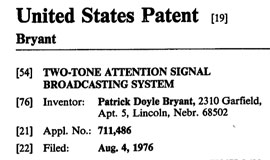
One aspect of the former patent is quite interesting: The patent was
issued to an apartment dweller in Nebraska, about seven years after the two-tone format was finalized.
Updated 6/5/2009:
Just recently I received an email from the "apartment dweller in Nebraska," Patrick Bryant. Back when
he was awarded the aforementioned patent, he was a broadcast engineer. Today he is a licensed pilot, CISSP,
GMDSS Operator/Maintainer, and amateur radio operator N8QH — a man with lots of feathers in his cap.
Note... The two-tone signal is now just a sound effect.
FCC
Rules §11.12: Effective January 1, 1998, the two-tone Attention Signal decoder will no longer
be required and the two-tone Attention Signal will be used to provide an audio alert.
The following item is a single page from a book called, "In Time of Emergency - a citizen's
handbook on nuclear attack and natural disasters." (Office of Civil Defense
publication H-14.)
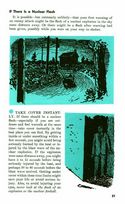 What
to do if there is a nuclear flash. Not exactly
"duck and cover", but along the same lines. (575 k-bytes)
What
to do if there is a nuclear flash. Not exactly
"duck and cover", but along the same lines. (575 k-bytes)
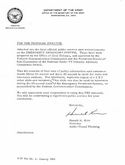
This
is a cover letter from the Department of the Army to all radio and television program directors
introducing a series of Public Service Announcements about the "new and improved"
Emergency Broadcast System.
This cover letter was accompanied by the following six pages:
Scripts for 60-second PSA's:
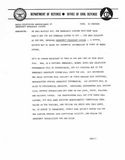
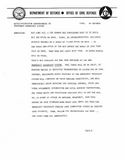
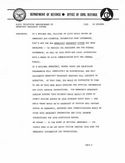
Scripts for 20-seconds PSA's:
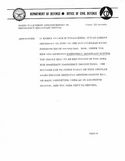
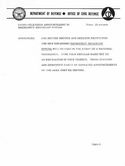
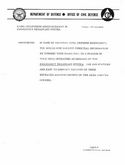
In addition to monitoring the AP wire, radio (and TV) stations monitor other radio stations to this
day, listening for EAS messages. Under the new
system, each station typically monitors an AM station, an FM station, and the nearest National Weather
Service VHF station. The operator on duty has to make a note in the transmitter log when
an EAS test is received. The same was true 35 years ago under the old system.
Unlike the old EBS system, the new EAS has weekly tests and monthly tests. Sometimes on consecutive
days – or perhaps even on the same day! It seems like a waste of time and effort when that
happens, but the two types of tests have slightly different purposes.
Back in the 1960's, FM stations were scarce, except in major markets, so the success of EBS depended on
regional and clear-channel AM stations. Minor stations in isolated small towns would
monitor big-city AM stations. To get enough of a signal to do this reliably, it was
sometimes necessary to construct an antenna, pointed in the direction of the station
to be monitored. One antenna ideal for this application is
the Beverage antenna.
Section Six: One more personal anecdote.
Added June 25, 2005.
In 1971 I had a First Class FCC license but very little work experience, so I was perfect for the job of
sign-on meter reader at KRGV, 1290 on your AM dial, (now KRGE) in Weslaco, Texas. Actually
I was hired as a part-time announcer, and more hours were added to my schedule when the boss gave me
the pre-sign-on transmitter shift that nobody else wanted. The AM station had a three-tower
directional antenna, which meant that somebody with a First Class license had to make a series of meter
readings before sunrise, while the station was still in the directional mode. Having someone
at the transmitter to turn it on in the morning was an advantage to everyone, because transmitters
like to warm up and wake up gently, especially on cold mornings, and in the event of an overload,
an engineer would be standing there to fix problems or put out the fire. An old man would have
found this to be a chore. I was only 17 and was having fun!
There is a picture of an identical
transmitter here.
While working as a radio announcer at KRGV, I was surprised to see that the announcer on duty had
no control of the transmitter. Most radio stations back then had transmitter controls
and telemetry — or the transmitter itself — right next to the
announcer. This station was an AM-TV combination, and all the meter reading was
done by the engineers at the TV transmitter, in their spare time. If they
remembered. Usually the engineers at the TV transmitter just ignored to AM transmitter altogether. As
a result of this arrangement, the KRGV-AM transmitter never went off the air during the "attention
signal" in EBS tests, as required by the
FCC rules.
Ahhh... but the transmitter had interlocked cabinets, of course, which meant that it would
go off the air instantly if certain doors were opened. The station's chief engineer was fully
aware of the EBS situation, and he knew that the TV transmitter guys ignored the AM transmitter. And
so, with his permission, I dropped by the transmitter and cut the carrier myself during the next
EBS test, using the interlocks to interrupt the carrier for five seconds at a time. Then
I made an entry on the maintenance log, locked the door, and left. That night, when the
post-sunset meter reader found the entry on the maintenance log, he called to find out what I
thought I was doing, who did I think I was, etc. It was a lively conversation. But
the boss loved it, since it showed that somebody took an interest in running an EBS test
the right way.
This goes to show that the old EBS system, and in particular the old attention signal, were
ineffective and unreliable in some parts of the country. In the case of KRGV, even the
people who were supposed to have been monitoring the transmitter never noticed that
it was off the air twice for five seconds at a time. Back in those days, just going
off the air wasn't much of an attention grabber. Nearly every station signed off every
night. (It seems hard to imagine, but really, you could tune around the AM band
at 2:30 a.m. and find several frequencies with no signals at all. Or maybe that was
just on my radio.) These days, transmitters are more reliable and many stations
are on the air continuously for months at a time, so it would be hard to overlook a five-second
interruption.
Even with its flaws, the new EAS system is a great improvement over the old Emergency Broadcast System.
"The price of freedom is eternal vigilance."
